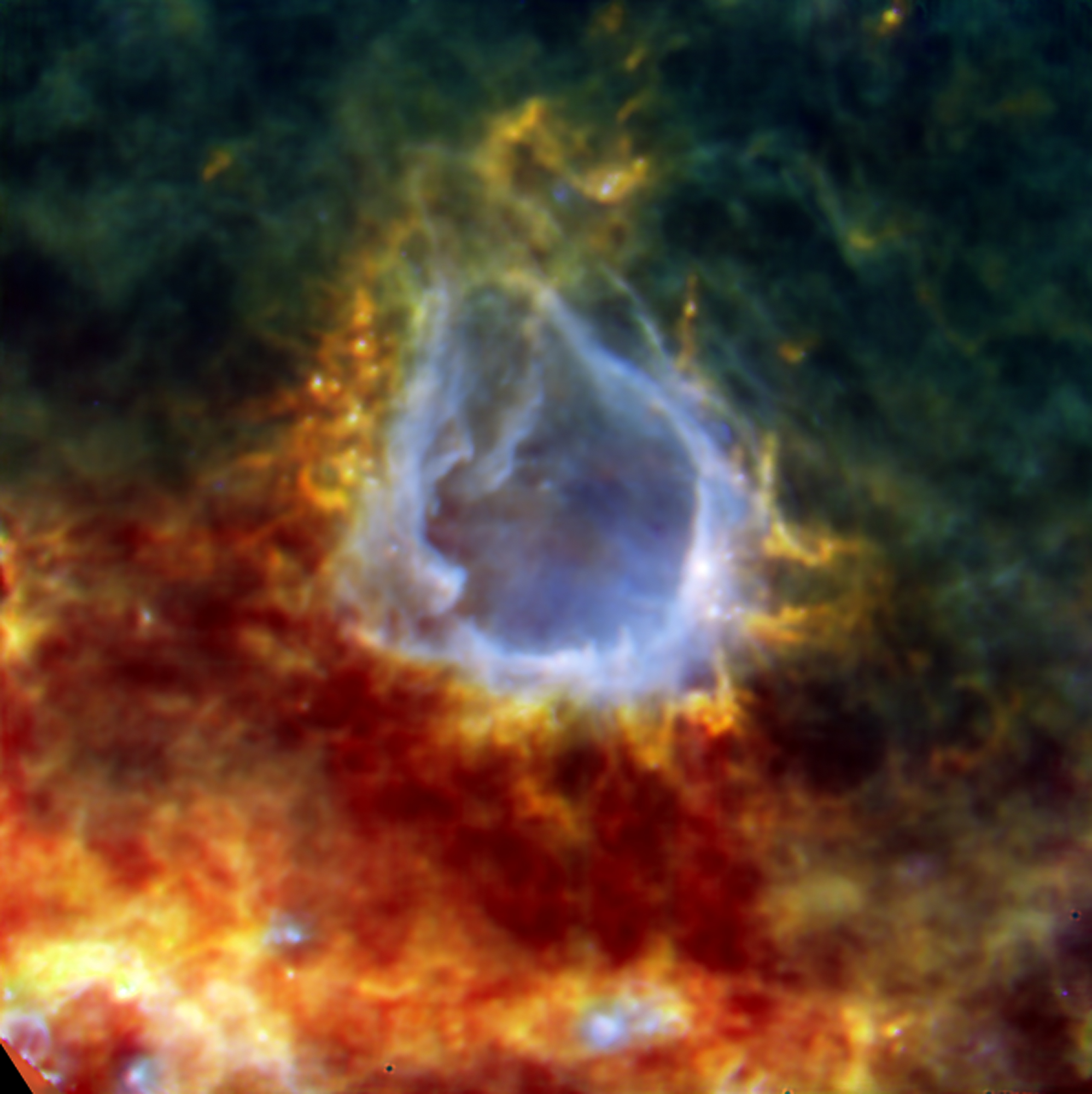As with previous mission phases, there is no clear transition between SDP and routine operations. As each project received its SDP data, if no significant problems were revealed, the Principal Investigator (PI) was invited to have a release telecon with the Project Scientist and HSC staff to discuss the data and any problems or issues that had arisen. If no serious issues were identified, the PI was invited to release all, or part of the observations in his or her programme for scheduling, in which case, the observations would be made available to the HSC Mission Planners. The first routine observations were observed on 18 October 2009 and, by December, the immense majority of scheduled observations came from released routine programmes. Over the course of the mission Herschel will produce hundreds, or thousands of spectacular images like this one Figure 1.6

Figure 1.6. Nebula RCW 120 in Scorpius, observed with PACS and SPIRE on 23 April 2010. This RBG image uses the PACS 100 and 160 micron bands for B and G respectively and SPIRE for the R. A giant star forming in the centre is blowing away the surrounding gas and dust to form the bubble.
Herschel will carry out routine science operations phase for a minimum of 3 years. Early on, mainly Guaranteed Time and "Key Project" observing programmes will receive priority. Key Projects will be performed early in the mission to permit follow-up and to give the Guaranteed Time holders at the HSC the opportunity to obtain real data to work with, in preparation for supplying community support to the open time observers with the benefit of a thorough knowledge of the entire observing chain from proposal submission to access and reduction of data.
All observers can track the state of their proposals from the (password protected) proposal handling pages of the HSC Web page and will be notified when the resulting data has been passed through the Quality Control process; this may take from 2-3 weeks to complete, although data is available for retrieval from the HSC usually within 48 hours of the observations being executed. Observers can also check both what observations are scheduled for observation and have been delivered to MOC (http://herschel.esac.esa.int/observing/ScheduleReport.html) and the observing log (http://herschel.esac.esa.int/observing/LogReport.html) from the HSC.
Table 1.1. Herschel mission key dates. Only approximate dates can be assigned to the different mission phases as there is inevitably a progressive transition between mission phases rather than a sharp one; in extreme cases there may be activities from three different mission phases progressing simultaneously and, in some cases, the start and end of a phase is a matter of definition and different dates could be given to the ones that appear here. In particular, HIFI recovery activities meant that CoP and PV days were scheduled months after the nominal end of these phases. Similarly, as reflected by this table, occasional PV days were being scheduled for PACS and SPIRE long after even routine observations had started.
| Mission phase | Approximate Start | Approximate End |
| Launch | L=14 May 2009 | |
| Early Orbit Phase | L | 24 May 2009 (L+10 days) |
| Commissioning Phase | L | July 19th (L+66 days) |
| Performance Verification Phase | 17 July 2009 (L+64 days) | 25 November 2009 (L+195 days) |
| Science Demonstration Phase | 11 September 2009 (L+120 days) | 30 April 2010 (L+352 days) |
| Herschel Routine Phase | 18 October 2009 (L+157 days) | L+40 months (baseline estimate); Boil-off = B |
| Run-down phase (3 months) | B | B+3 months |
| Mission consolidation phase (6 months) | B+3 months | B+9 months |
| Active archive phase (48 months) | B+9 months | B+57 months |
| Archive consolidation phase (6 months) | B+57 months | B+63 months (End of Herschel mission) |
| Historical archive phase (indefinite) | B+63 months | (TBD) End of all Herschel activity |
The Herschel post-operations phase will consist of the rundown monitoring phase (starting at the moment of helium boil-off), mission consolidation phase, active archive phase, and the archive consolidation phase (at which point the transfer to the subsequent historical archive phase takes place), which is the final formal phase of the mission.
The goal of this phase is, within the constraints of time and available resources, to maximise the scientific return from the Herschel mission by facilitating continuing widespread effective and extensive exploitation of the Herschel data. This will continue after the conclusion of this phase (i.e. in the historical archive phase).
The ultimate legacy of Herschel will be the historical archive, plus the sum of all the knowledge, both scientific and technical, derived from implementing and operating Herschel.
The historical archive phase is outside the funded Herschel mission. This phase commences after the end of the post-operations phase.
The historical archive will provide access to all Herschel observations and derived products. The products will all be derived in the archive consolidation phase during the post-operations phase in a consistent manner and to consistent standards using the best knowledge of Herschel instrument calibration and data processing. In addition, the software, documentation - manuals, etc.- and tools will be available from the historical archive.